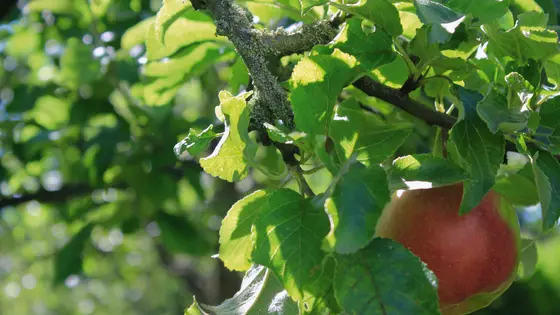

Harvesting and storing apples
- Discover
- Gardening inspiration
- Magazine
- Harvesting and storing apples
One highlight of autumn is the apple harvest. In this season of mellow fruitfulness, the Germans look forward to their favourite fruit, the apple.
Did you know, for example, that the apple belongs to the rose family and that there are some 20,000 varieties worldwide? Or that in Germany the per capita consumption of apples is 17.6 kg and the most popular varieties are Golden Delicious, Idared, Jonagold and Gala? Or that an apple needs around 30 green leaves for optimum growth and that you can recognise a ripe apple from its broad and deep calyx and brown pips? What? You didn't know all that? Well, you're no different from many other people.
But there are many more things worth knowing about the apple. Many mistakes can be made with the apple harvest and the storing of the fruit. Nothing is more annoying than biting into an apple that has been harvested wrongly or too early, where the aroma has not been able to develop correctly and the vitamins have not had a chance to form properly.

Essentially, apples must always be picked with caution. Please don't just rip them off the branches. An apple is only ripe for harvesting when it can be picked easily, i.e. when the stalk of the apple comes away from the tree easily if you twist it.
Further indications of an apple being ready to harvest are a wide and deep calyx and brown pips. Readiness for picking and eating differs, however, from variety to variety.
And as well as making sure you pick apples at the right time, it is important to avoid putting yourself in danger, since picking often involves some daredevil moves. This is because the best-looking apples always hang hidden away right at the top of the tree and are consequently difficult to reach. So please always consider your safety and use a fruit picker, for example, when picking ripe apples which are high up. By using the GARDENA combisystem fruit picker in conjunction with a telescopic handle, you can easily reach apples which are hanging right at the top of the tree without putting yourself in any danger.
Fruit is particularly delicious in the winter but also particularly expensive. There's no need to spend lots of money to get delicious apples in winter if you know how to store apples correctly. Apples can be stored for a long time through winter in the right conditions.
It is important to keep apples in a cool, dark place with plenty of humidity. A cellar with ventilation is suitable for this. If there is insufficient humidity, you can increase it by putting containers of water in the place where the apples are being stored.

Not all varieties of apple are suitable for storing. Topaz, Freiherr von Berlepsch, Roter Boskoop and Pilot can be stored.
The apples should either be stored on fruit racks or in flat boxes. The boxes can be lined with wood shavings or corrugated paper. In the case of taller boxes, we recommend putting corrugated paper between the layers of fruit to prevent pressure marks.
Please only store healthy and undamaged fruit. Maggot-ridden, overripe and outsized fruit cannot be stored for long and should be sorted out when harvesting. Apples without a stalk should be eaten early as they can rot quickly.
Check your fruit store on a weekly basis and remove all rotten apples. Rotten pipfruit can 'infect' other fruit. This is due to emerging ethylene, a colourless gas, which ripens the other apples more quickly and, in some cases, spoils them. For precisely this reason apples should not be stored together with other fruit and vegetables.
In order to prevent apples from drying out quickly, the boxes can be covered with a perforated film. Alternatively, apples can also be stored in perforated polythene bags since the release of ethylene is reduced by the bag. In all cases, stored pipfruit should be checked regularly so that rotten apples can be removed quickly.
If you follow these rules you will be able to bite into a juicy apple from your own garden in winter, too.
